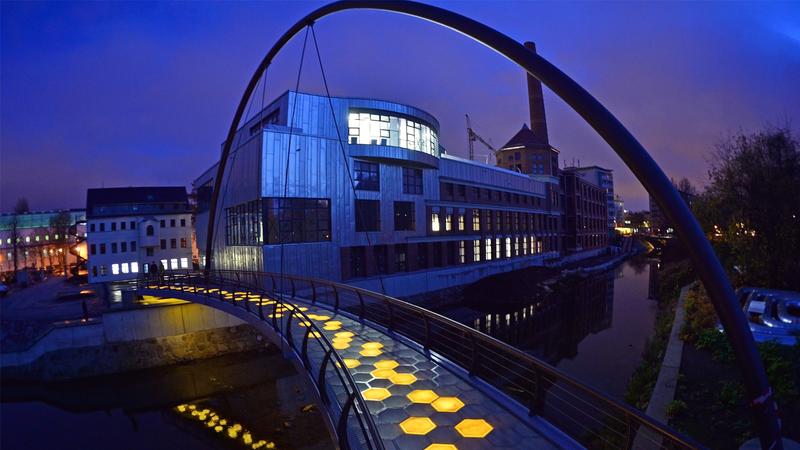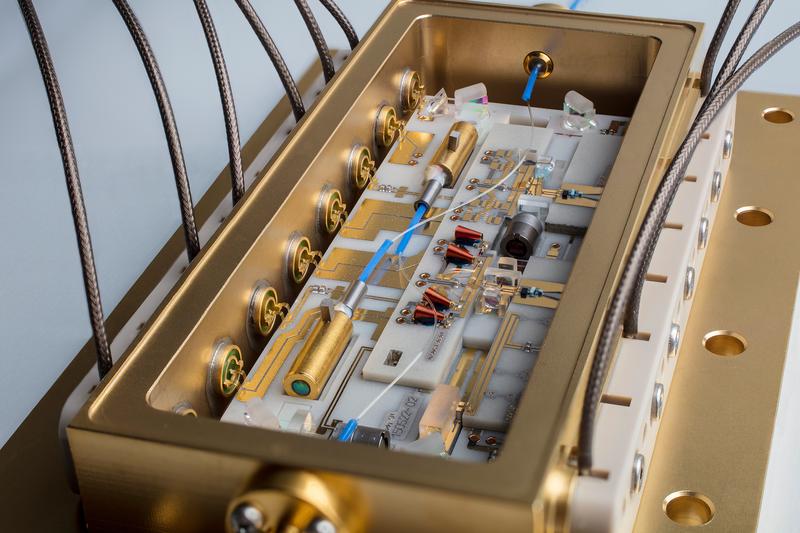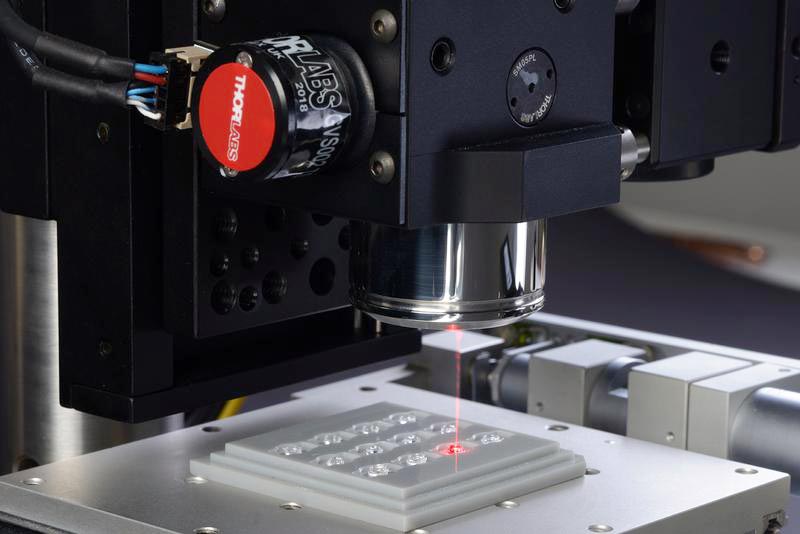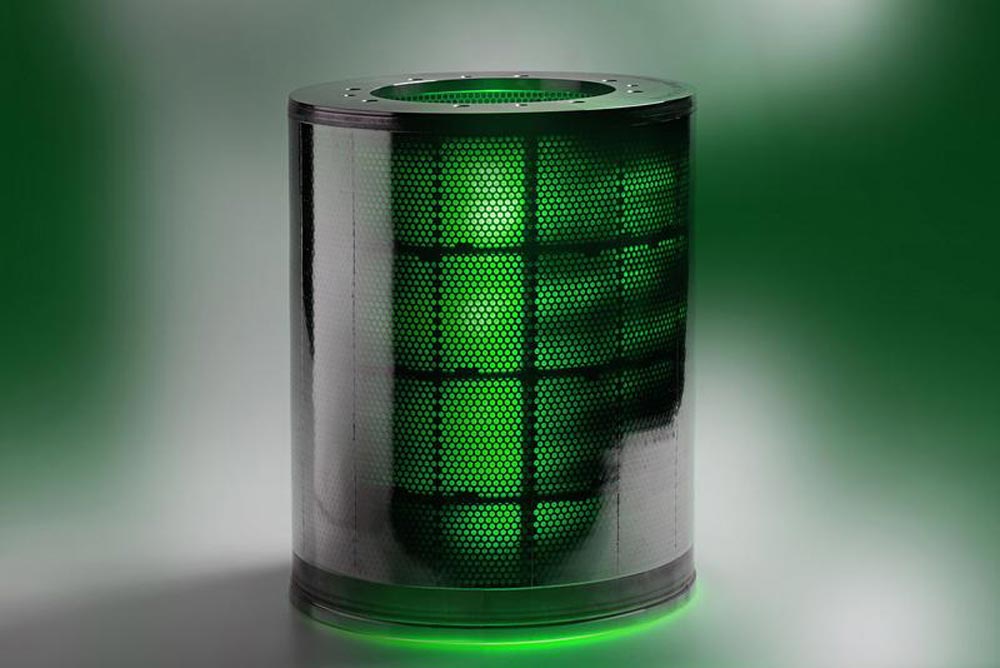

A demonstration model: Visitors to this lightweight bridge can illuminate honeycomb elements just by walking across them.
Photo: TU Chemnitz/Hendrik Schmidt
The symbiosis between technical textiles and lightweight construction creates completely new opportunities for product and technological development in many sectors. Examples of applications in automotive and mechanical engineering, medical and recreational sectors as well as many other industries will be presented from May 29-30, 2018 at the International Trade Fair for Technical Textiles mtex+ and the LiMA Lightweight Construction Fair in Chemnitz.
For the first time, the tandem event will feature the “light.building” special exhibition, developed in cooperation with the “Lightweight Constructions in Civil Engineering” research area at the Chemnitz University of Technology Institute of Lightweight Structures.
Interactive Biofacade for a Chemnitz Company
High-strength structures constructed from fibers and textile-structures instead of heavy bricks, concrete and steel – this is the formula, greatly abbreviated, by which the weight of construction components can be reduced. Researchers in Chemnitz present a multifunctional facade system based on sustainable raw materials such as flax fibers embedded in a resin system.
These layers envelop a corrugated cardboard core like a sandwich. Lighting elements are also integrated, by which the facade can be converted into a usable monitor. This biofacade was created as part of a project at the TU in collaboration with the Richter & Hess GmbH and FiberTech Construction companies in Chemnitz. Soon, it will be installed at Richer & Hess GmbH’s new production hall and will welcome customers and other guests to the facility.
Honeycomb Bridge and Concrete Furniture
A demonstration model of an interactive honeycomb bridge made of GFRP elements (glass-fiber reinforced plastic) depicting the original bridge, which spans the Chemnitz River and features a curved walkway that is 2.5 meters wide and 32 meters long, will also be on display at the special exhibition.
This project was also made possible through cooperation with industry partners. For the first time, lightweight honeycomb modules made of textile-reinforced hybrid composite materials were employed as weight-bearing structures in bridge construction. However, the bridge is not freely accessible to the public as it is located on the company premises of Baby Smile Fotografie GmbH & Co. KG.
Visitors to the Messe Chemnitz exhibition will also have a chance to view furniture as well as bionically-formed multifunctional elements made of textile-reinforced concrete. In addition, the show will also feature models allowing visitors to experience firsthand the difference between lightweight and traditional solid construction.
Unique Position in the German Research Sector
“Lightweight construction not only contributes to a reduction in weight, but also enables us to use resources more efficiently. The freedom in the design process, the integration of additional functionalities, for example through the use of sensors, as well as the sustainability resulting from the use of renewable resources are all additional advantages that can be achieved while ensuring the same structural properties as with classical systems,” explains Dr. Sandra Gelbrich, Leader of the “Lightweight Constructions in Civil Engineering” research group at TU Chemnitz.
What truly sets lightweight construction in Chemnitz apart is the close connection among competencies in material sciences, mechanical engineering and civil engineering. “When we develop a new material we also consider suitable manufacturing techniques. This combination affords us a unique position in the German research sector,” emphasizes Dr. Gelbrich. She continues: “We also place great value on the fact that our work is very user-focused and can be practically implemented.” Visitors to the special exhibition can also attend the accompanying lecture program focused on bionic-inspired lightweight structures in civil engineering and the application of bionic principles in mobile lightweight architecture.
Excellent Connections: Technical Textiles Meet Lightweight Construction
“This newly conceptualized exhibition exemplifies the continuing growth at the intersection of the fields of technical textiles and lightweight construction. This also applies to other exhibition areas, such as automotive and mechanical engineering. Consequently, we are bringing the two trade fairs mtex+ and LiMA even closer together. This is expressed in our new slogan “Excellent connections: Technical textiles meet lightweight construction,” explains André Rehn, C³ GmbH Chemnitz Director of Trade Fairs and Markets. He goes on to cite additional advantages of the partnership:
“Furthermore, in the central German industrial region, which is hosting, so to speak, shows extraordinarily strong research and development potential in these domains. They are truly realizing our visions of the future. No less important to the exhibitors and visiting professionals are the excellent connections that we offer. Anyone who visits our small but high-quality and affordable tandem trade fair knows: I have more time and opportunities to develop and maintain reliable business relationships here in Chemnitz than at other larger, unwieldy events, predominated by quick and hustled activity. We are laying the foundation for the long-term, sustainable quality of such contacts.”
Background: International Trade Fair for Technical Textiles mtex+ and the LiMA Lightweight Construction Fair
The trade fair combination of mtex+ and LiMA invites visitors to Messe Chemnitz on May 29 and 30, 2018. While mtex+ places its focus on functionalized and intelligent textiles, digitalized production, process development, textile finishing, composites and sustainability and recycling, LiMA prioritizes lightweight construction materials and products, manufacturing processes and production technology and the latest developments in lightweight construction from research.
Alongside the exhibition on lightweight construction, various additional themes will be highlighted. “flexible.protect”, for instance, is a brand new special exhibition on protective and safety textiles. The “health.textil” specialist exhibition on medical, nursing and wellness textiles will be presented again, following its success in 2016. The exhibit will be supplemented by a dialogue forum made up of decision-makers from the textile and healthcare industries.
Visitors can also pick up inspiration for new ideas, developments and partnerships at the “Chemnitz Ideas Factory” or the international cooperation exchanges, which place particular focus on participants from Eastern Europe. The Specialist and Student Day presents the manifold professional opportunities available in the future-oriented fields of technical textiles and lightweight construction for school-aged or university students as well as people with professional experience.
The Chemnitz Textiles Technology Conference is also part of the trade fair program. The conference, held on May 28 and 29, 2018 at Messe Chemnitz, will welcome around 300 experts from Germany and abroad. A central theme of the conference will also be the link between modern textile manufacturing and diverse applications of lightweight construction.
More Information: www.mtex-lima.de/en/
Contact: Dr. Sandra Gelbrich, Department of Lightweight Structures and Polymer Technology, phone 0371 531-32192, e-mail sandra.gelbrich@mb.tu-chemnitz.de.
(Translation: Sarah Wilson)












